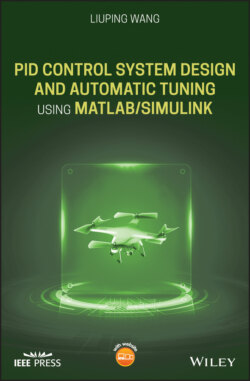Читать книгу PID Control System Design and Automatic Tuning using MATLAB/Simulink - Liuping Wang - Страница 22
1.2.4 PID Controllers
ОглавлениеA PID controller consists of three terms: the proportional (P) term, the integral (I) term, and the derivative (D) term. In an ideal form, the output of a PID controller is the sum of the three terms,
(1.32)
where is the feedback error signal between the reference signal and the output , and is the derivative control gain. The Laplace transfer function of the PID controller is
(1.33)
If the design is sound, the sign of is positive. If the sign of is negative, the derivative control term is to be neglected and instead a PI controller should be chosen.
Analogously to the proportional plus derivative controller described in Section 1.2.2, for most of the applications the derivative control is implemented on the output only with a derivative filter. For this reason, the control signal is expressed in the following form:
(1.34)
Figure 1.9 shows the block diagram of the PID controller structure.
To reduce the overshoot in output response to a step reference change, the proportional term in the PID controller may also be implemented on the plant output. In this case, the control signal is calculated using
(1.35)
Accordingly, the Laplace transform of the control signal is expressed as
(1.36)
Figure 1.10 shows a block diagram of the alternative PID controller structure (called an IPD controller).
The example below is used to illustrate the effect of the derivative term in the closed-loop control. The starting point is the PI controller designed in Example 1.3, based on which a derivative term is introduced.
Figure 1.9 PID controller structure.
Figure 1.10 IPD controller structure.
